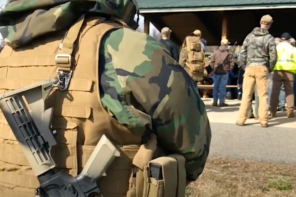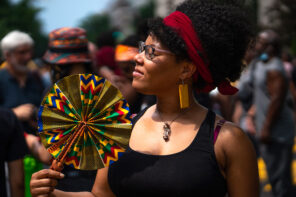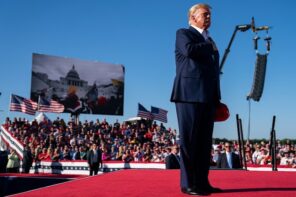In 1967, sociologist Robert Bellah published his now classic essay on “Civil Religion in America.” His bold thesis hinged on a spatial metaphor: namely that, running parallel to whatever specific traditional commitment most Americans claimed, there was a genuinely independent religious tradition in which all citizens of the United States participated. This was what Bellah called the American civil religion. The matter of parallelism was important; here was an independent tradition that did not touch the particular commitments of particular religious traditions like Christianity, Buddhism or Islam.
This civil religion has it own sacred documents (the Declaration of Independence, the US Constitution, the Ten, yes ten, Bills of Rights), its own sacred founders (Washington), its sacred martyrs (Lincoln) and its sacred shrines (cemeteries at Gettysburg and Arlington, any number of memorials on the Washington Mall, and more recently, Oklahoma City, the Pentagon and Ground Zero in New York). Perhaps most important, the US civil religion boasts its own calendar of “secular” holidays. These days, actually constituting a quasi-sacred calendar, span the entire calendar year: New Year’s Day, the King Holiday, President’s Day, Memorial Day, the Fourth of July, Labor Day, Columbus Day, Veteran’s Day, and now, at long last, Thanksgiving Day.
One of the interesting aspects of Bellah’s genealogy of the US civil religion is the way it took shape under pressure of perceived crises, each involving a war, and each located in a different century. So the Revolutionary War provided us with our founding myths and our founding father in the Moses-like character of George Washington. Hebraic images of the city on a hill, and a new Promised Land were prominent then (so, too, was the disturbing implication that indigenous Americans were Canaanites, and thus fit for destruction).
The Civil War provided the American civil religion with a new dimension of more explicitly Christian symbolism: the original sin of human enslavement was overcome only through the punitive bloodbath of civil war and the Christ-like sacrifice of the blood of the then-US President, Abraham Lincoln (Gary Laderman’s important book, The Sacred Remains, tells the disturbing story of how Lincoln’s corpse itself became an important artifact for public display, until its corruption provided an alternative-, and almost anti-, myth of national salvation).
For Bellah, writing in 1966 (the essay was reprinted in a collection of essays entitled Beyond Belief in 1970), the American civil religion was then involved in what he called its “third time of trial.” Surprisingly, he was not thinking about the Civil Rights movement; he was thinking about Vietnam. Given that the spiritual heart of the American civil religion was, for Bellah, a largely prophetic caution against idolizing the nation, and the importance of holding it accountable to transcendent standards of ethical behavior and international justice, Bellah’s decision to focus on foreign rather than domestic policy is less surprising. It also enabled him to extend his thesis that the times of civic trial were primarily focused on wars and their aftermath.
One fascinating question for the Bellah thesis about the US Civil Religion is whether a new century and this new war, provide the US civil religion with a new opportunity for growth, adaptation and change. And while the prophetic mode has been rather muted under the leadership of the Bush team, it will be fascinating to see how a new administration under the aegis of a very different kind of leader, will deploy the quasi-religious rhetoric of the American civil religion to make its own plea for prophetic national self-renewal.
Some of the most intriguing implications of the Bellah thesis were reserved for footnotes. The essay began with a quotation from President Kennedy’s Inaugural Address, one in which the President invoked the name of “God,” but did not specify which God he had in mind. This lack of specificity was crucial for Bellah; the political invocation of “God” in presidential rhetoric was intended as a non-sectarian unifier, one which could only serve that political and cultural purpose by remaining undefined. Were a US President to add a phrase, such as “the God we see revealed in Jesus Christ,” the entire edifice of US civil religion would ironically collapse.
In a footnote, Bellah noted that a US President did not dare to invoke the name of “God” in an Inaugural Address until 1821, when President Monroe did so for the first time. In other words, fully one generation passed before US President’s dared invoke the name of God. Prior to that, they had contented themselves with curious Deist circumlocutions like the Author of Nature, Providence, and Design.
President Wahington had already proposed that the nation establish a day of public thankfulness, but the holiday was not set in stone according to Bellah until the Civil War, when Lincoln pushed for it. So this holiday lies at the very junctures Bellah outlined in his influential essay. While the Thanksgiving Day newspaper is full of flyers encouraging the Christmas commercialism that begins tomorrow, this holiday is precious to many US citizens precisely for it simplicity and sometimes elegance. It is a day devoted to quiet pleasure, good food, good drink, family and friends. It is decidedly uncommercial, and refreshingly low-key. As Americans gather at dinner tables across the country, those who find themselves desiring to offer up a prayer of thanksgiving at a table where not all of their family and guests share a traditional commitment, the invocation of God, without qualifier, does significant and meaningful work, indeed.




